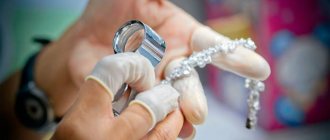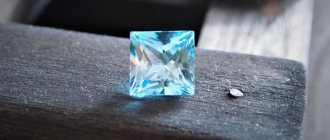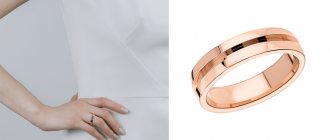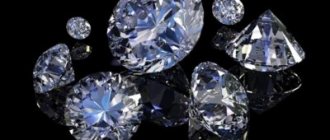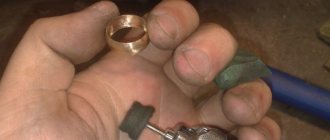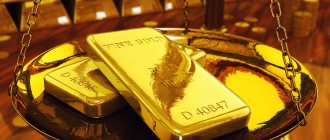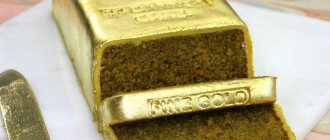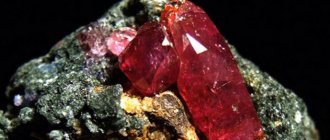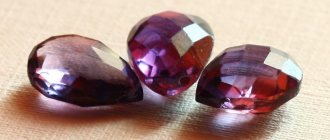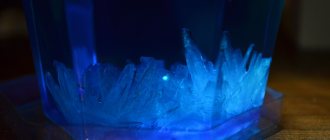How to determine whether a ruby is real or fake at home. This question is not uncommon on forums; the problem has become especially relevant since the mid-20th century, when advances in chemistry and metallurgy made it possible to grow artificial rubies on an industrial scale. It is difficult to distinguish synthetic stone from natural stone, but if you know some secrets, it is quite possible.
Properties of natural ruby
The features of this stone are unique; no mineral in the world has the same qualities as a natural ruby; experienced jewelers can very easily distinguish a fake from an original based on these features.
Hardness _ A real ruby is classified as first class in hardness, on the Mohs scale - 9. The gemstone is resistant to mechanical damage, it is difficult to leave a crack or scratch, and in its hardness it is second only to diamond.
Cut . Due to the hardness of the stone, it is very easy for jewelers to work with; an experienced craftsman can create clearly defined edges.
Color . Pink, coral, and red-burgundy rubies are found in nature. One of the most valuable rubies is bright red with a purple tint.
Shine. This mineral is characterized by a glossy shine and red highlights when illuminated.
The price of ruby passion
Rubies are not only the brightest stones, but also one of the most expensive, surpassing even diamonds in value. If we are talking about high-quality, pure and transparent ruby, then the price can reach hundreds of thousands of dollars and more.
The most expensive example, called Sunrise, was sold at Sotheby's for almost $30.5 million.
That is, approximately a little more than 1 million per carat! And today this is a record.
The second record holder is the largest ruby - its size is 440 carats. Found quite recently in Greenland. It is still unnamed, but it is not difficult to guess that such a stone will be given a name to match.
There are also cheap, low-quality rubies, these are often sold in Indian markets. Their cost is about 25 rupees per carat (that's less than 1 dollar). A bracelet made from such stones will cost about 2,000 rupees (about $30).
Types of rubies
Let's look at what types of rubies nature created.
Burmese. This species came to us from the place where rubies were mined. Specimens are found in Myanmar. It has a very bright rich red color. The stone has a high price, and just by the price you can determine whether it is a fake or not. Each cut Burmese ruby has a certificate and its own catalog number.
Ruby pigeon blood
Pigeon blood. This representative of rubies has a purple glow. Its cost is comparable to diamonds. It is practically impossible to counterfeit this type, because you will have to combine several components with metallic impurities, trying to maintain special properties.
One of the varieties is the star ruby. Many jewelers call such stones a natural miracle. It is distinguished by an internal glow that resembles a star in shape. It is almost impossible to repeat in a synthetic imitation, even for an experienced jeweler.
Ruby of natural origin is characterized by such colors as: light red, bright red, dark crimson. We can find such a rare specimen as a dark red ruby with a purple sheen.
Mining rubies - when will nature run out of stones?
Mining such stones is not an easy task; rubies are found in rock layers at considerable depth, and ruby deposits are gradually decreasing. Scientists have calculated. That in a thousand years a person will extract the last natural stone from the depths.
The highest quality and most expensive rubies are mined in Myanmar (formerly Burma); stones from this deposit are also called “pigeon blood” because, in addition to their blood-red color, they have a purple tint. Pigeon blood is also found in Vietnam.
The city of Mong Shu in India also boasts exceptional rubies, most of which are black with red edges. They are often even more expensive than pigeon blood because they are extremely rare. Almost the entire population of the city is engaged in crystal mining.
Each deposit produces its own stone, which varies in shade; the third largest deposit is in Ceylon, where rubies of a unique coral color are mined. Although they are not as sought after as blood red, their price is also high.
However, recent studies have shown that even in these layers very few crystals remain. The last stone will be mined soon, which may indicate a further increase in the price of this unique mineral.
Differences between ruby and garnet
The brilliance of garnet is significantly inferior to ruby, rubies shine like diamonds, and garnet has a muted shine; in natural light it has a matte shine. In shade it leans more towards brown. Garnet has the property of magnetization, which ruby does not have.
Ring with garnet
Differences from tourmaline
Tourmalines are very similar to rubies; in particular, light red and pink rubies are counterfeited with tourmaline. Jewelry craftsmen identify such counterfeits in the following way: they illuminate the mineral with ultraviolet light. When exposed to ultraviolet light, the ruby remains red, and the tourmaline changes its color to an orange sheen.
Noble spinel
For a long time, it was difficult for jewelers to distinguish a ruby from a noble spinel. But today it is known that spinel is an oxide of magnesium and aluminum, and ruby is an aluminum oxide, the red color of both minerals is due to the presence of chromium in the composition.
Does an artificial mineral have healing and magical properties?
Natural ruby is valued not only for its beauty, but also for its magical properties, including attracting wealth and good luck in love, helping to wisely lead people. The healing effect of the mineral is also high.
Another thing is imitation ruby. There is no magical energy in glass or plastic, in crystals grown from salt or sugar.
The properties of a composite ruby, that is, an alloy of glass and a real ruby component, allow us to talk about its effect on the owner. However, this effect is less pronounced than the influence of a natural gem.
Artificial stone, that is, grown in laboratory conditions, has more modest healing and magical properties. Although disputes on this matter do not stop.
Sources
- https://VelesLife.ru/kamni/kak-raspoznat-rubin.html
- https://jgems.ru/interesnoe/kak-otlichit-rubin
- https://planeta-mineral.ru/oberegi/kak-opredelit-rubin.html
- https://vkamen.ru/interesno/kak-otlichit-rubin
- https://lubikamni.ru/rubin/kak-otlichit-nastoyashhij-ot-iskusstvennogo.html
- https://vplate.ru/kamni-i-mineraly/iskusstvennyj-rubin/
- https://MoyKamen.com/vidy/iskusstvennye/iskusstvennyj-rubin.html
- https://mineralmarket.ru/articles/kak-otlichit-rubin-ot-poddelki.html
- https://sunmag.me/sovety/07-12-2014-kak-opredelit-podlinnost-rubina.html
- https://provsekamni.ru/kamni/rubin-iskusstvennyj
- https://velestone.ru/mineraly/oblagorozennyj-rubin/
- https://KakOtlichit.ru/accessories/jewellery/rubin.html
Is corundum a ruby or not?
Let's take a little look at corundum and ruby - they have a number of similar properties. People may even think that the differences between these stones are very insignificant. Both minerals are considered to have high strength, characteristic luster, and are resistant to chemical attack.
Corundum is mined in the USA, India, Greece, Sri Lanka, Madagascar, Tanzania, Russia, Norway, Ceylon, and Canada. Corundum has one of the highest forms of density and hardness, and is in no way inferior to ruby. The color range that is characteristic of corundum:
red, black, green, pink, white, and this is the first difference from ruby. Such a wide color palette of the mineral distinguishes it from ruby.
Ruby and sapphire jewelry
The fashion for ruby and sapphire jewelry has remained unchanged for many centuries. Gems are widely used in jewelry and are part of all kinds of products: earrings, rings, bracelets, necklaces, etc. Young ladies should not have a question about what looks more expensive – a ruby or a sapphire. Both gems are stones of the highest order and a magnificent addition to the wardrobe of fashionistas. Ruby goes well with gold - white and yellow, as well as silver. Photos of jewelry with ruby stone confirm this.
Sapphire looks best with silver or white gold. The abundance of different options allows you to choose jewelry for both everyday wear and special occasions.
Photos of gold jewelry with a sapphire stone indicate that the gem is in perfect harmony with white gold. No woman will refuse such jewelry!
How are rubies counterfeited in the modern world?
In 1857, the French chemist Marc Gaudin managed to obtain an artificial stone through synthesis; he fused two salts - alum and potassium chromate, obtaining ruby crystals.
In 1896, French scientist Auguste Verneuil grew the first synthetic minerals. He made a specialized furnace with a hydrogen-oxygen burner for the synthesis of rubies. This method began to gain popularity, and the era of industrial production of synthetic jewelry stones began, which immediately swept across Europe.
How is stone grown?
Synthetic rubies were first produced in France. In 1892, Auguste Verneuil proposed a method of growing rubies from aluminum oxide and small admixtures of other metals to give a characteristic color. During production, the components are melted in the fire of a hydrogen-oxygen burner, and the flowing drops form a mineral weighing up to 30 carats in a few hours.
The scientist’s idea became the basis for the development of technologies for growing other precious stones. Rubies grown by “pulling” single crystals from a melt (Czochralski method), crystallization from the gas phase, hydrothermal method, etc. are used on an industrial scale. Today, the method of growing rubies using nanotechnology is gaining popularity.
The production of artificial rubies takes place in a chemical laboratory or production environment, which, of course, cannot be achieved at home. At home, as a gift, you can grow ruby from potassium hexacyanoferrate (III). To create such an “artificial ruby”, you need:
- bring 350 ml of water to a boil, then remove from the stove and cool to 90–95 degrees;
- dissolve 200 g of potassium hexacyanoferrate (III) in hot water;
- lower a small pebble to the bottom, close and put the container with the solution in a dark place for 2-3 weeks.
During this time, a “ruby” stalagmite will “grow” on the pebble. It is important that the liquid completely covers the formation. As soon as the “synthetic ruby” begins to rise above the level of the solution, you need to remove it and dry it. Potassium hexacyanoferrate (III) is a toxic substance, so when working with it you must use protective equipment (respirator, gloves, apron and safety glasses).
Modern methods of producing synthetic stones
Verneuil's method. This method is carried out by melting a charge; in the case of ruby, the charge is a mixture of aluminum and chromium oxides. The furnace has a technology so that in a flow of oxygen the charge falls down, falling into the combustion chamber where hydrogen is supplied and where the burner is located.
A melting process occurs, and the resulting droplet falls on a ceramic substrate, on which a boule is formed, with a diameter of 2 cm and a length of up to 5-10 cm. More than 100 types of crystals have been developed to date using this method.
Czochralski method
Czochralski method. It is a method of producing crystals of very high quality. This method allows you to obtain rubies, which are a quality material for jewelers.
Zone melting
The method is technologically simple. A mixture of the previously calcined oxides of the main components with impurities and a seed is placed in a molybdenum boat, which is slowly pulled along the heater. As the boat moves, a narrow zone appears in the charge, which, with further movement, solidifies to form a single crystal. The resulting crystal measures approximately 8 cm, height 2 cm, length 18 cm.
Method of garnissage melting. The material is melted and crystallizes within its own cold zones. When cooled, columnar crystals form.
Hydrometric synthesis method. This process is carried out by crystallization of the mineral in solutions of low-melting compounds (lead, boron and other elements).
How to identify a real ruby at home
When purchasing jewelry with a red stone, you need to make sure of its authenticity. Of course, no one can check this kind of work better than an experienced jeweler. But if you can’t contact a knowledgeable technician, you can check it yourself.
Synthesis methods
The first synthetic ruby was obtained by a scientist from France - Auguste Verneuil. This gave a huge impetus to the production of the gem in large quantities for almost all countries. In addition, thanks to the scientist, other minerals began to be grown. The technology by which an artificial crystal was first obtained is called the Verneuil Method. It is as follows:
- the mixture of oxides is placed in a special hydrogen-oxygen burner (Verneuil furnace);
- substances are melted using fire;
- During the cooling process, the droplets form a crystal.
The gem grows in the form of first an expanding cone and then a cylinder. Surprisingly, using this method you can get a ruby after just a few hours.
Currently, methods for obtaining synthetic ruby can be completely different:
- Czochralski method;
- a method for purifying solids based on the different solubility of impurities in the solid and liquid phases;
- crystallization from solutions in a melt;
- crystallization from the gas phase;
- a method for producing various chemical compounds and materials using physical and chemical processes in closed systems occurring in aqueous solutions at temperatures above 100°C and pressures above 1 atmosphere.
If, when purchasing precious jewelry, you still do not want to become the owner of a synthetic ruby, but prefer its natural analogue, then you should not be afraid. Currently, there are strict rules and regulations that oblige sellers to clearly indicate the names of jewelry stones. So, the tag must indicate whether the mineral in the product is natural or artificial. Selling synthetic rubies under the guise of natural ones is punishable by law, so jewelry stores that value their reputation and name will never commit such fraud.
Effective Methods for Testing Natural Ruby
One of the simple and quick methods is to place the stone on a closed eyelid; the fake one heats up immediately, but the natural ruby remains cold, as it is a poor heat conductor.
Take the mineral in your hands in natural light, pointing it towards the sun; the side facing the sun will shine and shimmer, while the opposite side will remain dull. If you see this, then this is a real mineral.
Test in liquid
Place the jewelry in an empty glass container. If pale red radiation appears, then this is a real ruby. You cannot see such a glow from an artificial sample.
This method, of course, raises doubts, but it is worth mentioning. If you place a real ruby in a container of homemade milk, the liquid will acquire a characteristic pink tint.
Under ultraviolet light, a genuine ruby remains red, while a fake ruby turns orange.
How to check the authenticity of a breed at home
If you want to know more about a stone that has already been purchased and is at your disposal, you can try to check its authenticity yourself, at home. There are several ways to do this.
- Option one. Prepare any glass container. It doesn’t matter what volume and shape it will have, the main thing is the transparent walls. Place the pebble in the bowl. If it is a real ruby, regardless of the carat, it will glow with beautiful red rays. A fake does not have this effect.
- Method two. Examine the pebble in the light (natural lighting is a must). If this is a real ruby, then in the sun it will sparkle with different shades depending on the degree of lighting. Opposite the sun, the mineral will glow burgundy, and on the other side it will glow with a pale and matte light.
- The third method is using milk. A ruby is placed in a glass of milk. If it changes color to pink, then the gem is real. And the point here is not in chemistry, but in the optical effect - the stone glows so brightly that the illusion of coloring the milk is created.
- The fourth method is exposure to ultraviolet light. The synthetic analogue will remain red under UV rays, while the genuine samples will take on a warm orange tint.
- The fifth method is to study the internal component. In fake and real stones you can see bubbles inside, but in the former they are filled with air, and in the latter they are filled with gases.
- Method six - strength test. If you try to scratch the surface of a ruby with glass, the scratches will come out uneven. In imitations, damage of this kind is usually straight and glossy.
- Method seven - heating. Natural rubies heat up very slowly. It is easy to feel if you hold the stone in your palm. Imitations quickly absorb the heat of the human body. By this feature they can be easily distinguished from the original.
The weight of the mineral is another important property to pay attention to. Original breeds are always noticeably heavier than fakes, harder and more solid.
